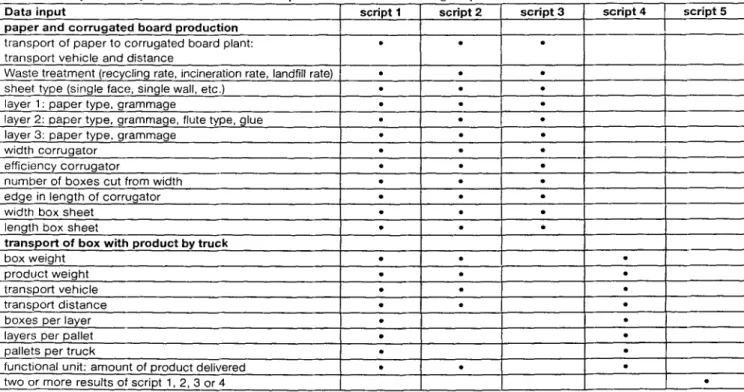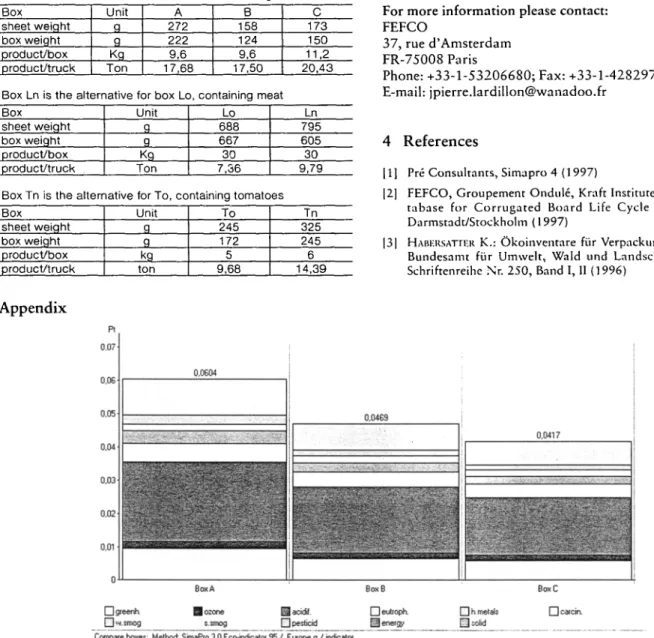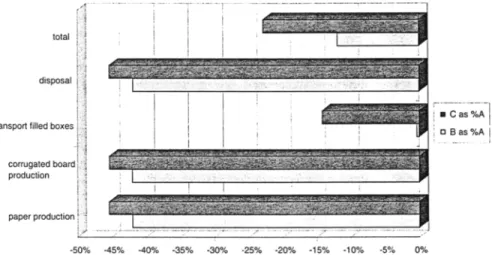LCA Software Report
LCA for Corrugated Board
LCA Software Report
LCA Software Tool for Corrugated Board
Bringing LCA Within Easier Reach of the Industry
~Angeline S.H. de B e a u f o r t , 2Ueli Stahel
*FEFCO-Groupement Ondul~-Kraft Institute, Paris, France
2Swiss Federal L a b o r a t o r i e s for Materials Testing and Research (EMPA), St. Gallen, Switzerland C o r r e s p o n d i n g a u t h o r : Angeline S.H. de Beaufort
Abstract
FEFCO, Groupement Ondul~ and Kraft Institute have integrated the data from their recently published updated "European Da- tabase for Corrugated Board Life Cycle Studies" into a soft- ware tool that has been developed especially for the corrugated board industry. The tool links input and output data reported in the Database to average European data for upstream and downstream processes from BUWAL 250 [3]. The tool is in- tended to support environmental management of companies since it provides a possibility to find opportunities for improve- ments and to take environment into consideration when design- ing corrugated board boxes.
The entire system of corrugated packaging is the basis for the calculations. It is assumed that the fibres that are used for the production of the corrugated base papers are produced and re- cycled only within this system. This simplified so-called closed- loop approach, which is described in detail in the Database re- port, avoids the problem of allocating impacts caused by primary fibre production and the final treatment of corrugated packag- ing that is not recycled between primary and recovered fibre based paper grades. This means that with the software tool it is not possible to make comparisons between the production of primary fibre and recovered fibre based materials as such. The tool enables the user to vary parameters such as transport, box design, logistics and waste management according to his personal circumstances, In this way he can use the tool to intro- duce parameters for possible alternatives he wants to investi- gate. The LCA results of these alternative cases can then be com- pared and analysed at inventory, characterisation, normalisation and weighing level. The user cannot change the basic data nor the methodology.
Keywords: Corrugated board, LCA, software tool; Life Cycle Assessment, corrugated board, software tool; software to01, LCA, corrugated board
1 Introduction
Corrugated packaging is used in many different applications with a large variety of design, logistics and waste manage- ment. The industry as a whole has gained knowledge based on case studies over the years. These case studies, performed
by LCA specialists, have been based on certain specific ap- plications and circumstances. Results o f the studies were not always c o m p a r a b l e due to choice of different background data, system boundaries etc.
A more flexible form o f LCA leading to comparable results was needed to bring the tool w i t h i n an easier reach for de- signers and decision m a k e r s in the industry. The LCA soft- ware for corrugated b o a r d , t h a t has n o w been developed, combines flexibility w i t h fixed choices. The user needs only elementary knowledge of L C A to u n d e r s t a n d the way the system is developed, which choices are made and how to interpret the results.
2
Description of the Software
The software tool is a light version of Simapro 4 [1] with scripts developed by the three Associations:
- F E F C O ( E u r o p e a n F e d e r a t i o n o f C o r r u g a t e d Board Manufacturers),
- G r o u p e m e n t O n d u l ~ ( G O ) , E u r o p e a n Association of M a k e r s of C o r r u g a t e d Base Papers and
- the Kraft Institute (KI), A s s o c i a t i o n of Virgin Fibre Based Producers of C o r r u g a t e d B o a r d M a t e r i a l s in Europe. The user does not have to design the L C A model by himself. He does not have to solve the p r o b l e m of finding data on the p r o d u c t i o n o f base p a p e r a n d c o r r u g a t e d board produc- tion, nor of h o w and to w h i c h u p s t r e a m and downstream processes he has to link these d a t a .
The software is based on the m o s t recent d a t a from the "Eu- r o p e a n Database for C o r r u g a t e d Life Cycle Studies" [2]. The r e p o r t contains e n v i r o n m e n t a l d a t a on the p r o d u c t i o n of corrugated base p a p e r s f r o m virgin fibres (Semichemical Fluting and Brown Kraftliner, d a t a from the Kraft Institute), recovered paper (Testliner a n d Wellenstoff, data from the G r o u p e m e n t Ondul~) a n d c o r r u g a t e d b o a r d production in Europe (data from F E F C O ) .
Int. J. LCA 3 (6) 317-320 (1998)
9 ecomed publishers, D-86899 Landsberg, Germany
L C A f o r C o r r u g a t e d B o a r d L C A S o f t w a r e R e p o r t
The data represent the mass-weighted averages for Europe of the inputs into and outputs from the production sites per ton net saleable product (paper and corrugated board) from the production sites.
The "European Database for Corrugated Life Cycle Stud- ies" is not a complete inventory.
Since the Database contains European data, the choice has been made to link these to public available European data for thermal systems, raw material inventories, electricity generation for the public grid (UCPTE), transportation and waste treatment from BUWAL 250 [3]. The process cards and scripts have been reviewed by EMPA.
The software uses the closed-loop approach (which is described in detail in the Database report) to avoid the problem of allo- cating the impacts caused by primary fibre production and the final treatment of corrugated packaging that is not recy- cled between primary anad recovered fibre bases paper grades. It is based on the assumption that the primary fibre produc- tion and recycling of the fibres only takes place within the entire system of corrugated packaging. Since fibres do not have an eternal life (fibres can be recycled a limited number of times only, not all fibres are recycled) a constant fresh
fibre flow is needed to feed the system. This approach is a simplification of complicated fibre flows through various paper production systems.
The software tool can be considered as a "flexible" LCA, where the user can choose a script and introduce the param- eters according to his personal situation. Examples of scripts and parameters belonging to each are described in Table 1.
3 Examples of Application
Producers of base papers, corrugated board producers and packers/fillers sit together to discuss several aspects of alter- native box designs, such as machinability, protection, com- munication, distribution simplification and material utilisa- tion. Using the software tool it takes only a little extra time to include the analysis and comparison of the environmen- tal impact of the alternatives.
As can be seen from Table 1 it is possible to make the com- parison at several levels. For example when logistics for tile ahernatives are the same, it should suffice to compare at sheet level using script 3; when only the logistics are differ- ent and the box sheet is the same it is sufficient to compare only the logistics part using script 4.
Table 1: Examples of scripts and connected variable parameters that can be changed by the user
Data input script 3 script 4 script 5 p a p e r a n d corrugated, board production
t r a n s p o r t o f p a p e r to c o r r u g a t e d board plant: ~ t r a n s p o r t v e h i c l e and distance
Waste t r e a t m e n t (recycling rate, incineration rate, landfill rate) ~ sheet type (single face, single wall, etc.) ~ layer 1 : p a p e r type, g r a m m a g e
layer 2: p a p e r t y p e , g r a m m a g e , flute type, glue layer ,3: p a p e r type, g r a m m a g e width c o r r u g a t o r efficiency c o r r u g a t o r n u m b e r of b o x e s c u t from width e d g e in length, of c o r r u g a t o r w i d t h b o x s h e e t length b o x s h e e t
transport of box with product by truck
b o x w e i g h t p r o d u c t w e i g h t
t r a n s p o r t vehicle 9
t r a n s p o r t d i s t a n c e ~
b o x e s p e r layer 9
laYers per pallet ~
pallets p e r t r u c k 9
f u n c t i o n a l unit: a m o u n t of p r o d u c t delivered ~
script 1 script 2
t w o o r m o r e results of script 1, 2, 3 or 4
Script 1: LCA corrugated board box truckkm: analyses the full LCA for products delivered by truck
Script 2: LCA corrugated board box tonkm: analyses the full LCA for products not delivered by truck or you do not have details on the number of boxes and the amount of product delivered by one truck
Script 3: LCA corrugated board sheet: for analysing the part "cradle to corrugated board production" (production included)
Script 4: LCA truck: for analysing the part "delivery of the product by truck", details on the number of boxes and the amount of product delivered by one truck and transportation distance available
Script 5: Compare LCA: comparing two or more LCAs you have made with script 1, 2, 3 or 4
9 : data the ucer is requested to fill in depending on the script he has chosen
L C A S o f t w a r e R e p o r t L C A f o r C o r r u g a t e d B o a r d
In most cases, howeveJ, it can be expected that the box de- sign influences the efficiency of the transport. Table 2 de- scribes three cases, where alternative boxes were compared. The functional unit was 1 ton of transported product for all cases. Figure 1 (---~
Appendix)
shows an example of the re- sult of comparing in Simapro for the alternatives A, B and C. Figure 2 shows examples of using the results from Simapro for the boxes described in Table 2 to show the increase or decrease for acidification potential as a percentage of the acidification potential of the original box system for several phases of the life cycle. The result is similar for other char- acterisation categories. These examples show that sometimes heavier boxes enable more efficient transports (more productTable 2: Examples of comparing alternative boxes
Box B and C are alternatives for box A, containing cookies Box Unit sheet weight g box weight g product/box Kg product/truck Ton A B C 272 158 173 222 124 150 9,6 9,6 11,2 17,68 17,50 20,43 Box Ln is the alternative for box Lo, containing meat
Box Unit Lo Ln sheet weight box weight product/box g g K9 Ton 688 795 667 605 30 30 product/truck 7,36 9,79 Box Tn is the alternative for To, containing tomatoes
Box Unit To Tn 245 325 sheet weight box weight product/box product/truck g g kg ton 172 245 5 6 9,68 14,39 A p p e n d i x
per box and/or more pallets per truck), leading to a higher environmental impact when the boxes are compared at sheet level, but lower impacts when the whole system is considered. Script 2 can be used when one wants to compare alternative transportation processes, using European averages of load- ing efficiencies.
The LCA tool will be u p d a t e d when new or u p d a t e d databases, evaluation methods etc. are available. Scripts may be changed or new scripts may be added according to wishes of the users.
The software is atso available for others than members of the three Associations. Introduction courses are organised for the users.
For more information please contact: FEFCO 37, rue d'Amsterdam FR-75008 Paris Phone: +33-1-53206680; Fax: +33-1-42829707 E-mail: jpierre.lardillon@wanadoo.fr 4 Ill [21 131 R e f e r e n c e s Pr6 Consultants, Simapro 4 (1997)
FEFCO, Groupement Ondul~, Kraft Institute: European Da- tabase for Corrugated Board Life Cycle Studies, Paris/ Darmstadt/Stockhohn (1997)
H,UU~{SATrrR K.: Okoinventare ftir Verpackungen, Schweizer Bundesamt fi.ir Umwelt, Wald und Landschaft (BUWAL), Schriftenreihe Nr. 250, Band I, II (1996)
Fig. 1: Example of comparing alternative boxes for cookies (ecoindicator 95)
LCA for Corrugated Board
LCA Software Report
Fig. 2 a: Comparing contributions from phases in the life cycle of alternative boxes (acidification); boxes for cookies
Fig. 2 b: Comparing contributions from phases in the life cycle of alternative boxes (acidification); boxes for meat
Fig. 2 c: Comparing contributions from phases in the life cycle of alternative boxes (acidification); boxes for tomatoes


